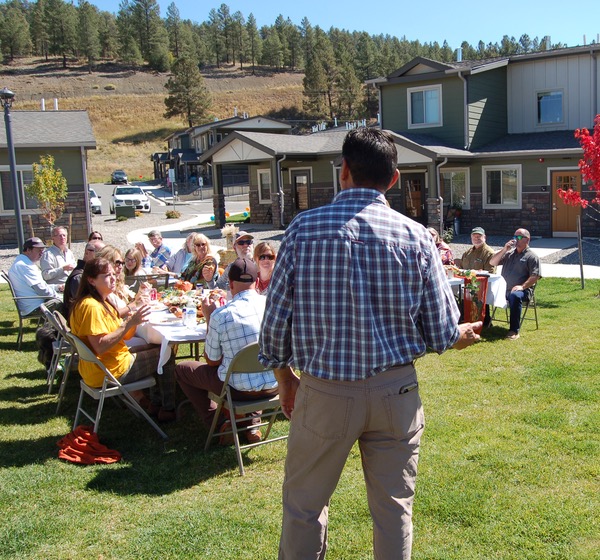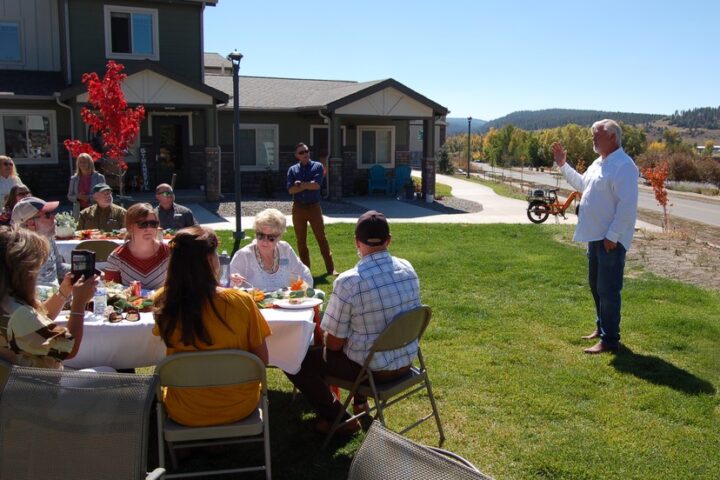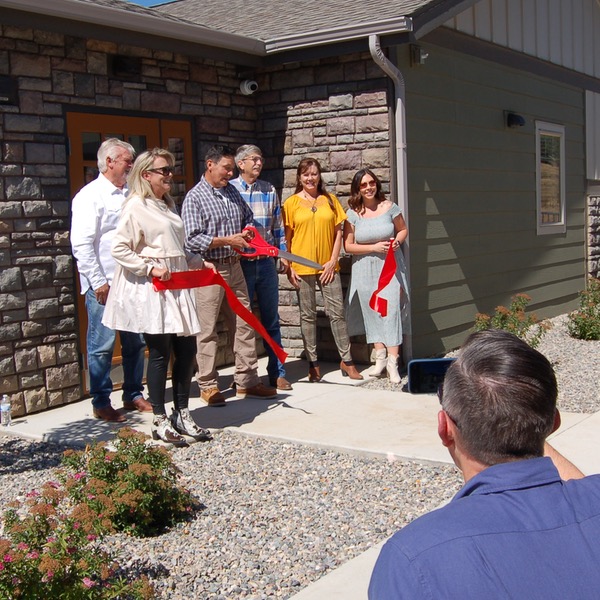The usual suspects gathered for lunch and a ribbon-cutting ceremony at Rose Mountain Town Homes, on Friday, September 29, to celebrate one of the very few successful workforce housing efforts in Pagosa Springs in recent years.
Just to be clear, I count myself among the usual suspects — meaning about two dozen local leaders and volunteers who’ve been watching the worsening housing crisis in Archuleta County, and trying to do something about it.
Not an easy challenge.
Here, below, is a photo of the gathered officials and volunteers listening to words of thanks from former Archuleta County commissioner Clifford Lucero, who helped lead the effort to get the Rose Mountain low-income housing complex built…
…a five-year effort plagued by numerous roadblocks, not least of which being the ongoing shortage of workers in Archuleta County’s construction industry, massive supply chain problems during the COVID crisis, and the generally higher cost of construction in a semi-isolated rural community.
Mr. Lucero is currently board chair for the Archuleta County Housing Authority (ACHA), one of several groups involved in the Rose Mountain project. ACHA originally proposed to build housing on a steep hillside near the KWUF radio station, on property owned by the Town of Pagosa Springs, but shifted gears when the Board of County Commissioners offered to provide a long-term lease on a less challenging site directly across the street from Town Hall, on Hot Springs Boulevard.
That particular property had been purchased almost 20 years earlier as the potential site for new County facilities.
Here’s another photo of the gathering listening to additional words of gratitude, in this case from the project developer Bill Simpson. Mr. Simpson was formerly employed by the Colorado Department of Local Affairs, Division of Housing (DOH), and had made several visits to Pagosa Springs between 2010 and 2018, hoping to help our community — and our community leaders — get moving to address our workforce housing issues. He recalls it as a frustrating effort.
Following his retirement from DOH, Mr. Simpson decided (with the support of his wife) to take on a development project in Pagosa Springs — since no one else seemed willing to grab the bull by the horns, and since he had extensive experience at DOH working with housing projects.
“One last development project” is the way he described the decision.
Little did he know how difficult this particular project would turn out to be, in Pagosa, and in the midst of COVID.
The Rose Mountain project resulted from the Low Income Housing Tax Credit (LIHTC) program, a federally-subsidized housing program whereby wealthy investors earn tax subsidies in exchange for loaning out money for low-income housing. In order to qualify for an apartment at Rose Mountain, an applicant must be living on an income that amounts to about half, or less, of the “median” income in Archuleta County.
“Median” meaning the halfway point. So, half of the halfway point. Or less.
Thanks to the fact that our tourism-based economy generally pays relatively low wages, most of the residents at Rose Mountain are active members of our workforce.
Back in July 2018, the Daily Post received a press release from the Pagosa Fire Protection District, the taxpayer-supported agency that has been operating as a “volunteer fire department” since at least the 1980s. Currently, the District operates with about a dozen paid staff and about 45 volunteer firefighters.
The press release concerned “Volunteer Recruitment” and was sent out by Lt. Megan Macht, the District’s Public Information Officer:
Can you fill these?? If not you, then who? If not now, then when???
Pagosa Fire Protection District is actively seeking volunteer firefighters. No experience needed, PFPD will provide beginning fire fighter classes and hands-on training.
Applicants must be over 18 years old, have a current drivers license, live in Archuleta County, must pass a background check, and be able to obtain a Colorado Fire Fighter I certification within six months.
Contact PFPD at 970-731-4191 or stop by Station 1 at 191 N. Pagosa Blvd for more information or an application.
Give back to your community by volunteering!
During the Fourth of July parade that year, the PFPD float had displayed a prominent banner urging us — any of us — to step up and volunteer to become trained firefighters.
Sharing this Fire District press release on the Daily Post, back in 2018, I was unable to recall, at any previous time during my 25 years in Pagosa Springs, hearing the PFPD making such obvious appeals for volunteers. For the previous two decades, the District had seemingly found it relatively easy to maintain a crew of trained volunteers ready and willing to charge into burning buildings.
By 2018, volunteers with the youthful energy needed for firefighting were already in short supply.
This was about the same time Clifford Lucero and Bill Simpson were approaching the BOCC for financial help with a possible LIHTC project. Fortunately for the community, the BOCC was willing to support the effort, which ended up celebrating — with last Friday’s ribbon cutting — the completion of, and full habitation of, 34 apartment units.
The complex includes one-, two-, and three-bedroom units. Residents pay rents equivalent to 30% of their monthly income. (According to a 2021 survey by Pagosa Housing Partners, low-income families in Archuleta County were typically paying about 50% of their monthly income for housing.)
Rose Mountain wouldn’t have been possible without the support of the government agency that administers the LIHTC program for the state: the Colorado Housing and Finance Authority (CHFA). According to Mr. Simpson, CHFA bent over backwards — in terms of grant funding — to help bring the project to completion.
As mentioned, Rose Mountain — even with sizable government subsidies from federal and state agencies — took five years to plan and build out. That amounts to only about seven units per year, if you average it out.
Another regular developer of workforce housing in Archuleta County, Habitat for Humanity, is trying to build three units per year.
That averages out to about 10 units per year, between those two developers.
A recent study by Root Policy Research suggested that, in 2019, Archuleta County was lacking about 800 workforce housing units.
Will it therefore take 80 years to address the shortage, at the current rate of development — 10 units per year?
Read Part Two…




